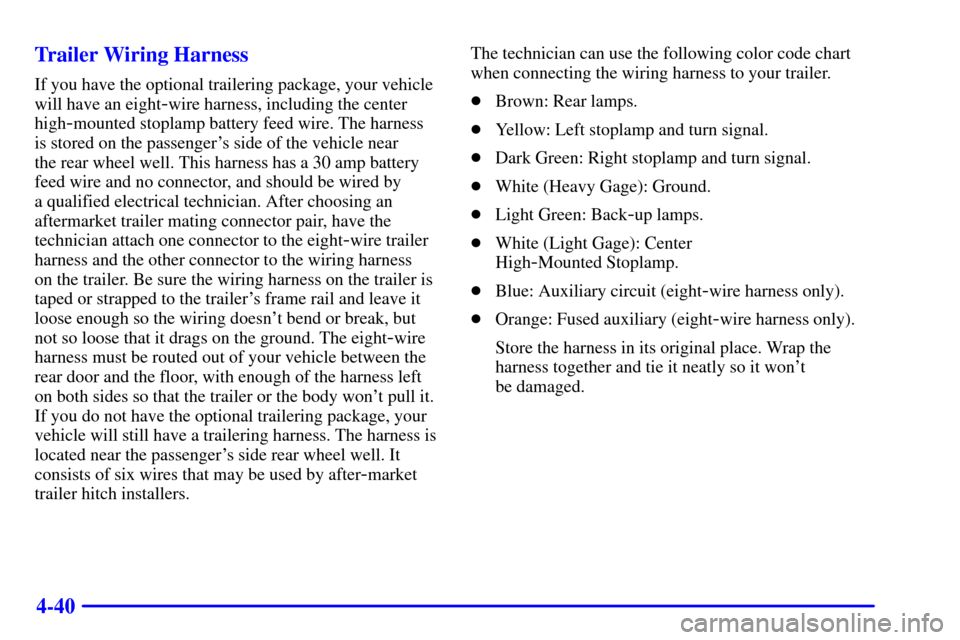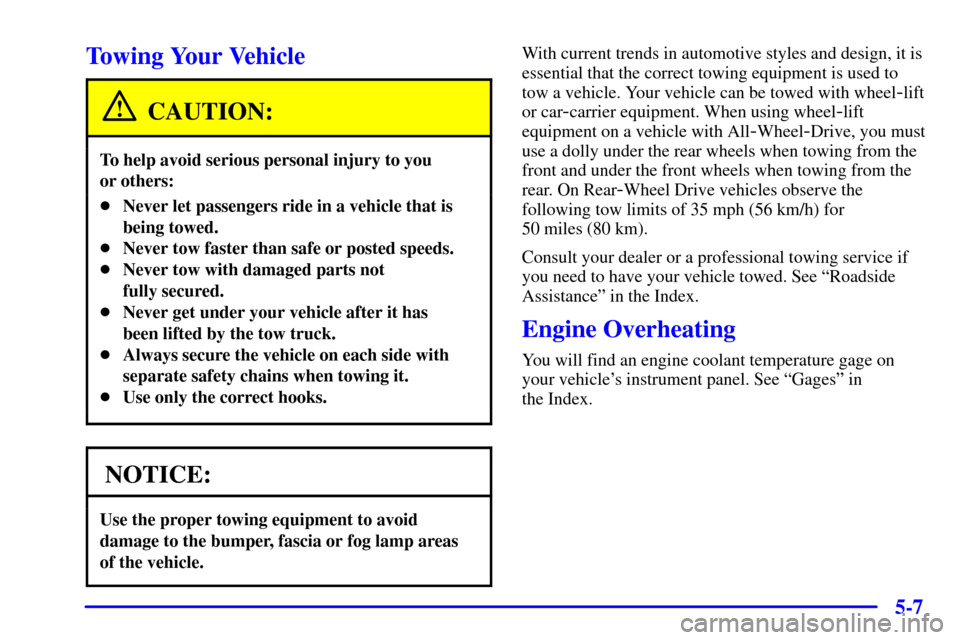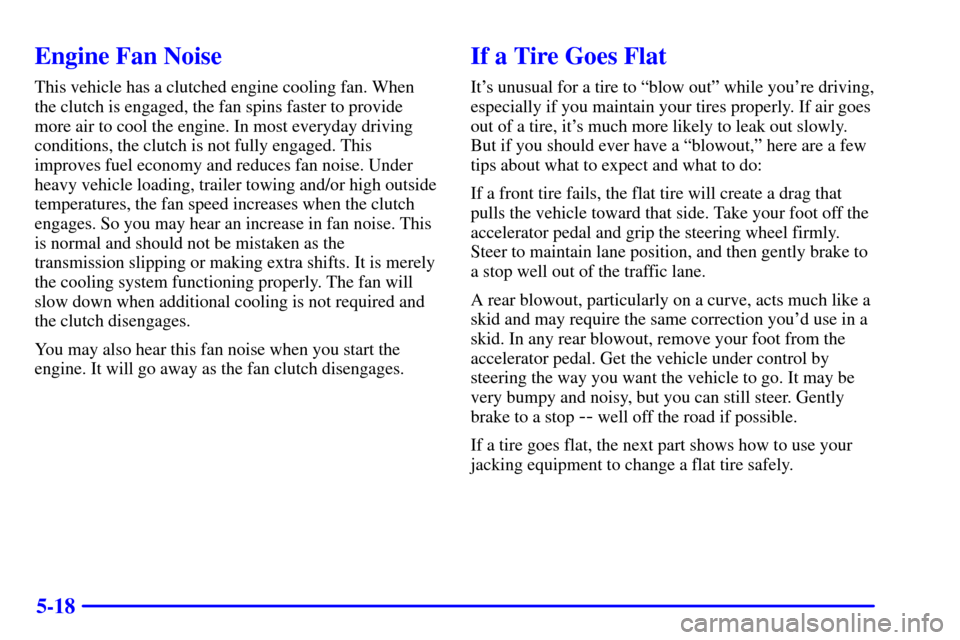Page 220 of 391

4-40 Trailer Wiring Harness
If you have the optional trailering package, your vehicle
will have an eight
-wire harness, including the center
high
-mounted stoplamp battery feed wire. The harness
is stored on the passenger's side of the vehicle near
the rear wheel well. This harness has a 30 amp battery
feed wire and no connector, and should be wired by
a qualified electrical technician. After choosing an
aftermarket trailer mating connector pair, have the
technician attach one connector to the eight
-wire trailer
harness and the other connector to the wiring harness
on the trailer. Be sure the wiring harness on the trailer is
taped or strapped to the trailer's frame rail and leave it
loose enough so the wiring doesn't bend or break, but
not so loose that it drags on the ground. The eight
-wire
harness must be routed out of your vehicle between the
rear door and the floor, with enough of the harness left
on both sides so that the trailer or the body won't pull it.
If you do not have the optional trailering package, your
vehicle will still have a trailering harness. The harness is
located near the passenger's side rear wheel well. It
consists of six wires that may be used by after
-market
trailer hitch installers. The technician can use the following color code chart
when connecting the wiring harness to your trailer.
�Brown: Rear lamps.
�Yellow: Left stoplamp and turn signal.
�Dark Green: Right stoplamp and turn signal.
�White (Heavy Gage): Ground.
�Light Green: Back
-up lamps.
�White (Light Gage): Center
High
-Mounted Stoplamp.
�Blue: Auxiliary circuit (eight
-wire harness only).
�Orange: Fused auxiliary (eight
-wire harness only).
Store the harness in its original place. Wrap the
harness together and tie it neatly so it won't
be damaged.
Page 228 of 391

5-7
Towing Your Vehicle
CAUTION:
To help avoid serious personal injury to you
or others:
�Never let passengers ride in a vehicle that is
being towed.
�Never tow faster than safe or posted speeds.
�Never tow with damaged parts not
fully secured.
�Never get under your vehicle after it has
been lifted by the tow truck.
�Always secure the vehicle on each side with
separate safety chains when towing it.
�Use only the correct hooks.
NOTICE:
Use the proper towing equipment to avoid
damage to the bumper, fascia or fog lamp areas
of the vehicle.
With current trends in automotive styles and design, it is
essential that the correct towing equipment is used to
tow a vehicle. Your vehicle can be towed with wheel
-lift
or car
-carrier equipment. When using wheel-lift
equipment on a vehicle with All
-Wheel-Drive, you must
use a dolly under the rear wheels when towing from the
front and under the front wheels when towing from the
rear. On Rear
-Wheel Drive vehicles observe the
following tow limits of 35 mph (56 km/h) for
50 miles (80 km).
Consult your dealer or a professional towing service if
you need to have your vehicle towed. See ªRoadside
Assistanceº in the Index.
Engine Overheating
You will find an engine coolant temperature gage on
your vehicle's instrument panel. See ªGagesº in
the Index.
Page 239 of 391

5-18
Engine Fan Noise
This vehicle has a clutched engine cooling fan. When
the clutch is engaged, the fan spins faster to provide
more air to cool the engine. In most everyday driving
conditions, the clutch is not fully engaged. This
improves fuel economy and reduces fan noise. Under
heavy vehicle loading, trailer towing and/or high outside
temperatures, the fan speed increases when the clutch
engages. So you may hear an increase in fan noise. This
is normal and should not be mistaken as the
transmission slipping or making extra shifts. It is merely
the cooling system functioning properly. The fan will
slow down when additional cooling is not required and
the clutch disengages.
You may also hear this fan noise when you start the
engine. It will go away as the fan clutch disengages.
If a Tire Goes Flat
It's unusual for a tire to ªblow outº while you're driving,
especially if you maintain your tires properly. If air goes
out of a tire, it's much more likely to leak out slowly.
But if you should ever have a ªblowout,º here are a few
tips about what to expect and what to do:
If a front tire fails, the flat tire will create a drag that
pulls the vehicle toward that side. Take your foot off the
accelerator pedal and grip the steering wheel firmly.
Steer to maintain lane position, and then gently brake to
a stop well out of the traffic lane.
A rear blowout, particularly on a curve, acts much like a
skid and may require the same correction you'd use in a
skid. In any rear blowout, remove your foot from the
accelerator pedal. Get the vehicle under control by
steering the way you want the vehicle to go. It may be
very bumpy and noisy, but you can still steer. Gently
brake to a stop
-- well off the road if possible.
If a tire goes flat, the next part shows how to use your
jacking equipment to change a flat tire safely.
Page 240 of 391
5-19
Changing a Flat Tire
If a tire goes flat, avoid further tire and wheel damage
by driving slowly to a level place. Turn on your hazard
warning flashers.
CAUTION:
Changing a tire can cause an injury. The vehicle
can slip off the jack and roll over you or other
people. You and they could be badly injured.
Find a level place to change your tire. To help
prevent the vehicle from moving:
1. Set the parking brake firmly.
2. Put the shift lever in PARK (P).
3. Turn off the engine.
4. Put the wheel blocks at the front and
rear of the tire farthest away from the
one being changed. That would be the
tire on the other side of the vehicle, at
the opposite end.The following steps will tell you how to use the jack and
change a tire.
Page 241 of 391
5-20 Removing the Spare Tire and Tools
The jacking equipment you'll need is stored by your
vehicle's rear doors, along the passenger's side wall.
Remove your jack cover by pulling it away from the
side wall and down to release the tabs securing the top
of the cover.
Remove the wheel blocks by turning the top nut
counterclockwise. Remove the nut and washer, then pull
the wheel blocks off the bolt. Push down on the bolt and
remove the hooked end from the slot. Slide the jack
toward the front of the vehicle and lift it from the
mounting. Remove the extension and the ratchet from
the pouch.
Page 243 of 391
5-22
Put the flat end of the extension on an angle through the
hole in the rear door frame, above the bumper. Be sure
the flat end connects into the hoist shaft.
Turn the ratchet counterclockwise to lower the spare tire
to the ground. Keep turning the ratchet until the spare
tire can be pulled out from under the vehicle.
When the tire has been
lowered, tilt the retainer
plate at the end of the cable
and pull it through the
wheel opening.
Pull the tire out from under the vehicle.
NOTICE:
To help avoid vehicle damage, do not drive the
vehicle before cable is restored.
Page 244 of 391
5-23
The tools you'll be using include the jack (A), wheel
blocks (B), extension (C) and ratchet (D).
Removing the Wheel Covers
You will have to take off hub caps or wheel nut caps to
reach your wheel nuts.
Styled Steel Wheel Shown
If you have a standard steel wheel, carefully pry along
the edge of the hub cap until it comes off. Be careful, the
rim edges may be sharp. Don't try to remove the hub
cap with your bare hands.
If you have the styled steel wheel or aluminum wheel
with plastic nut caps, loosen the plastic nut caps with the
ratchet and socket. Make sure the DOWN side
faces you.
To remove the hub cap from the aluminum wheel
without plastic nut caps, fit the flat end of the extension
into the notch. Then, remove the center cap.
Page 245 of 391
5-24 Removing the Flat Tire and Installing the
Spare Tire
1. Before you start, block the front and rear of the tire
farthest away from the one being changed. Then put
your spare tire near the flat tire.
2. With the DOWN side facing you, use the ratchet and
socket to loosen all the wheel nuts. Don't remove
them yet.
3. The jack has a bolt on the end. Attach the socket end
of the extension to the jack bolt.